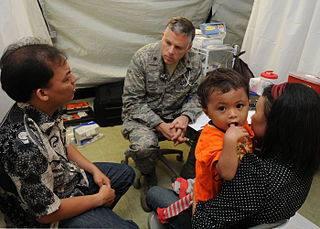Bioethics is both a field of study and professional practice, interested in ethical issues related to health, including those emerging from advances in biology, medicine, and technologies. It proposes the discussion about moral discernment in society and it is often related to medical policy and practice, but also to broader questions as environment, well-being and public health. Bioethics is concerned with the ethical questions that arise in the relationships among life sciences, biotechnology, medicine, politics, law, theology and philosophy. It includes the study of values relating to primary care, other branches of medicine, ethical education in science, animal, and environmental ethics, and public health.
Cross-cultural communication is a field of study investigating how people from differing cultural backgrounds communicate, in similar and different ways among themselves, and how they endeavor to communicate across cultures. Intercultural communication is a related field of study.
Interculturalism is a political movement that supports cross-cultural dialogue and challenging self-segregation tendencies within cultures. Interculturalism involves moving beyond mere passive acceptance of multiple cultures existing in a society and instead promotes dialogue and interaction between cultures. Interculturalism is often used to describe the set of relations between indigenous and western ideals, grounded in values of mutual respect.
Intercultural communication is a discipline that studies communication across different cultures and social groups, or how culture affects communication. It describes the wide range of communication processes and problems that naturally appear within an organization or social context made up of individuals from different religious, social, ethnic, and educational backgrounds. In this sense, it seeks to understand how people from different countries and cultures act, communicate, and perceive the world around them. Intercultural communication focuses on the recognition and respect of those with cultural differences. The goal is mutual adaptation between two or more distinct cultures which leads to biculturalism/multiculturalism rather than complete assimilation. It promotes the development of cultural sensitivity and allows for empathic understanding across different cultures.

Intercultural learning is an area of research, study and application of knowledge about different cultures, their differences and similarities. On the one hand, it includes a theoretical and academic approach. On the other hand, it comprises practical applications such as learning to negotiate with people from different cultures, living with people from different cultures, living in a different culture and the prospect of peace between different cultures.
Competence is the set of demonstrable characteristics and skills that enable and improve the efficiency or performance of a job. Competency is a series of knowledge, abilities, skills, experiences and behaviors, which leads to effective performance in an individual's activities. Competency is measurable and can be developed through training.
Cultural competence, also known as intercultural competence, is a range of cognitive, affective, behavioural, and linguistic skills that lead to effective and appropriate communication with people of other cultures. Intercultural or cross-cultural education are terms used for the training to achieve cultural competence.
Cultural safety is the effective nursing practice of nursing a person or family from another culture; it is determined by that person or family. It developed in New Zealand, with origins in nursing education. An unsafe cultural practice is defined as an action which demeans the cultural identity of a particular person or family.

The nurse–client relationship is an interaction between a nurse and "client" (patient) aimed at enhancing the well-being of the client, who may be an individual, a family, a group, or a community.
The Bennett scale, also called the Developmental Model of Intercultural Sensitivity (DMIS), was developed by Milton Bennett. The framework describes the different ways in which people can react to cultural differences. Bennett's initial idea was for trainers to utilize the model to evaluate trainees' intercultural awareness and help them improve intercultural sensitivity, also sometimes referred to as cultural sensitivity, which is the ability of accepting and adapting to a brand new and different culture.
The Hopkins Center for Health Disparities Solutions (HCHDS), a research center within the Johns Hopkins Bloomberg School of Public Health, strives to eradicate disparities in health and health care among racial and ethnic groups, socioeconomic groups, and geopolitical categories such as urban, rural, and suburban populations.

Cultural sensitivity, also referred to as cross-cultural sensitivity or cultural awareness, is the knowledge, awareness, and acceptance of other cultures and others' cultural identities. It is related to cultural competence, and is sometimes regarded as the precursor to the achievement of cultural competence, but is a more commonly used term. On the individual level, cultural sensitivity is a state of mind regarding interactions with those different from oneself. Cultural sensitivity enables travelers, workers, and others to successfully navigate interactions with a culture other than their own.

Holistic nursing is a way of treating and taking care of the patient as a whole body, which involves physical, social, environmental, psychological, cultural and religious factors. There are many theories that support the importance of nurses approaching the patient holistically and education on this is there to support the goal of holistic nursing. The important skill to be used in holistic nursing would be communicating skills with patients and other practitioners. This emphasizes that patients being treated would be treated not only in their body but also their mind and spirit.. Holistic nursing is a nursing speciality concerning the integration of one's mind, body, and spirit with his or her environment. This speciality has a theoretical basis in a few grand nursing theories, most notably the science of unitary human beings, as published by Martha E. Rogers in An Introduction to the Theoretical Basis of Nursing, and the mid-range theory Empowered Holistic Nursing Education, as published by Dr. Katie Love. Holistic nursing has gained recognition by the American Nurses Association (ANA) as a nursing specialty with a defined scope of practice and standards. Holistic nursing focuses on the mind, body, and spirit working together as a whole and how spiritual awareness in nursing can help heal illness. Holistic medicine focuses on maintaining optimum well-being and preventing rather than just treating disease.
A culturagram is a family assessment tool used in the practice of social work which was first introduced by Fordham University professor, Dr. Elaine Congress.
Cultural humility is the “ability to maintain an interpersonal stance that is other-oriented in relation to aspects of cultural identity that are most important to the [person].” Cultural humility is different from other culturally-based training ideals because it focuses on self-humility rather than being an other-directed "they/them" way of achieving a state of knowledge or awareness. It is helpful to see as others see; what they themselves have determined is their personal expression of their heritage and their “personal culture”. Cultural humility was formed in the physical healthcare field and adapted for therapists, social workers, and medical librarians, to learn more about experiences and cultural identities of others and increase the quality of their interactions with clients and community members.

Cultural competence in healthcare refers to the ability for healthcare professionals to demonstrate cultural competence toward patients with diverse values, beliefs, and feelings. This process includes consideration of the individual social, cultural, and psychological needs of patients for effective cross-cultural communication with their health care providers. The goal of cultural competence in health care is to reduce health disparities and to provide optimal care to patients regardless of their race, gender, ethnic background, native languages spoken, and religious or cultural beliefs. Cultural competency training is important in health care fields where human interaction is common, including medicine, nursing, allied health, mental health, social work, pharmacy, oral health, and public health fields.
Gerodiversity is the multicultural approach to issues of aging. This approach provides a theoretical foundation for the medical and psychological treatment of older adults within an ecological context that includes their cultural identity and heritage, social environment, community, family system, and significant relationships. Gerodiversity encompasses a social justice framework, which considers the social and historical dynamics of privilege and inequality. In addition to issues of aging, gerodiversity includes race, ethnicity, language, gender identity, socioeconomic status, physical ability or disability, sexual orientation, level of education, country of origin, location of residence, and religion or spirituality.
The Filipino American identity comprises principles from both the Philippines and the United States. Although the meaning of identity differs from one individual to another, the fundamental factors are the same. History, genetics, socio-economic status, culture, and education are all indirect factors that influences the identity of an ethnic group; thus, they are also reflective of a group's health beliefs and practices.
The Purnell Model for Cultural Competence is a broadly utilized model for teaching and studying intercultural competence, especially within the nursing profession. Employing a method of the model incorporates ideas about cultures, persons, healthcare and health professional into a distinct and extensive evaluation instrument used to establish and evaluate cultural competence in healthcare. Although the Purnell Model was originally created for nursing students, the model can be applied in learning/teaching, management, study and practice settings, within a range of nations and cultures.
Multicultural counseling is a type of counseling where the therapist addresses the struggles of a client whose race, gender, socioeconomic background, religion, or any other part of their identity doesn't fit in with the majority. Minorities have a history of dealing with racism and oppression, and in this lens, a counselor that doesn't take that information into account isn't able to effectively counsel. In the therapy session, the sociocultural environment of the individual and issues of power and privilege are given attention. This is a strengths based approach; counselors focus on positive change in both the process and the outcome.




